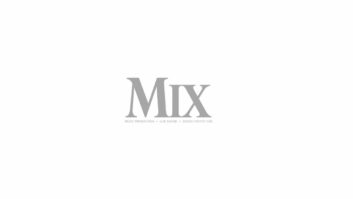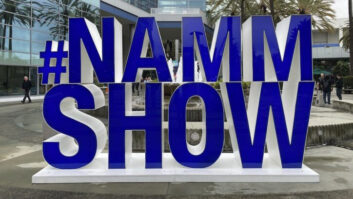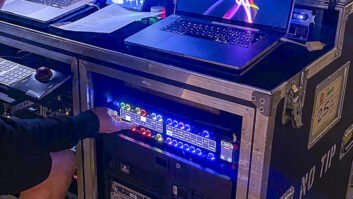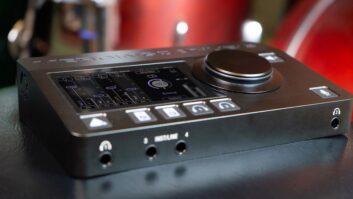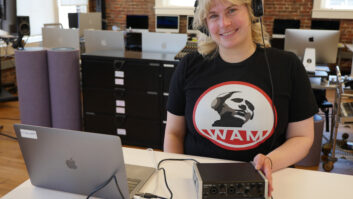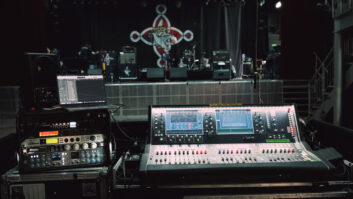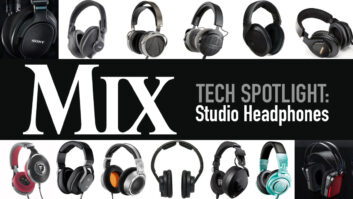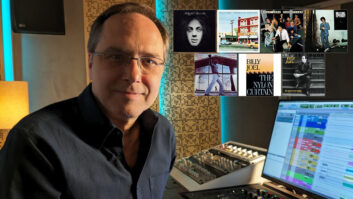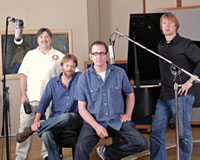
L-R: In the Broken Radio studio at 1340 Mission are Paul Stubblebine, Mike Winger, Matt Boudreau and Michael Romanowski.
Recording industry veterans may associate the 1340 Mission St. building in downtown San Francisco with Coast Recorders, a well-known studio that opened in 1969. Artists and engineers who worked there in the ’90s will remember it as Toast. Now, the property is simply called 1340 Mission, and partners Matt Boudreau and mastering engineer Michael Romanowski, along with industry vet/mastering engineer Paul Stubblebine and producer/engineer Michael Winger, are infusing the historic facility with a vibrant new energy by offering a classic recording space (redesigned by Bill Putnam in 1970), excellent equipment and talented personnel. Most importantly, it’s a place where musicians can work in an environment that emphasizes collaboration, communication and creativity rather than the more isolated situations that are now so common in our industry.
The facility turned a corner in 2007 when Boudreau decided to move and expand his Broken Radio studios and join Romanowski, who had worked in the building alongside industry vet Stubblebine since 2002. “Paul and I had been here for years and wanted someone else to run the recording studio,” says Romanowski. “When the lease came up for renewal, Paul asked me if I wanted to take it over, but I didn’t want to run a recording studio either! So I decided to find a partner who really cared about music, about building a scene and doing good work. Matt was the perfect choice.”
Expanding into a 30×40-foot studio was quite a jump for Boudreau, but the timing seemed ideal for him and Romanowski to bring their vision of a collaborative, creative environment to life. “For years, Michael and I talked about having a group of people in one facility,” says Boudreau. “Then he came to me one day, and said, ‘Well, do you want to move over and join me?’”
He and Romanowski put a plan into action that would not only incorporate their ideas for a community-based environment, but also put money in the bank. “Matt’s focus was to make the studio affordable and a model where everybody pays the same price,” says Winger. “His concept is very independent artist- and producer-friendly and more suited to today’s recording climate.”
On Stubblebine and Romanowski’s recommendation, Boudreau re-oriented the control room 90 degrees so that the window is positioned to the side of the console instead of directly in front. That alone opened up the 20×22-foot control room considerably.
“I struggled through making several records in here and felt it wasn’t ever going to work acoustically because the proportions were wrong with the window in front,” says Stubblebine. “With the console facing west, not only does it take the window out of the acoustical equation when monitoring, I find that it allows you to focus more on what you’re hearing.”
The Bob Hodas-tuned room features a 28-input Trident 16 console and a set of Klein + Hummel 0300 monitors with an 0800 sub. Recording options include Pro Tools HD2 Accel with Lynx Aurora converters and four Universal Audio UAD-1 expansion cards; Studer A827 2-inch analog with either 24- or 16-track headstack; and a Tascam DV-RA1000HD for high-resolution mixdown. Outboard gear includes Universal Audio mic pre’s and compressors, and an EMT 140 plate, among other items, and the solid mic list includes models from Royer, Neumann, Audio-Technica, Shure, Earthworks and BLUE.
While Broken Radio was settling into its new space, Stubblebine and Romanowski reconfigured their mastering studios and combined equipment to make space for the Tape Project, a record label of sorts co-owned by Stubblebine, Romanowski and Dan Schmalle that offers a limited number of reel-to-reel analog releases to a growing number of audiophile subscribers. Romanowski’s studio is now the duping headquarters for the Tape Project and home to the Scully lathe for album cutting.
Around the same time, Winger moved in his Pro Tools HD3 Accel rig, Yamaha and Genelec monitors, and other gear upstairs to create an intimate mix room in what was previously unused space.
With all rooms online, 1340 Mission has seen a flurry of activity, with clients ranging from George Winston, Joshua Redman and the Kronos Quartet, to regional talent such as Winger’s own band, Super Adventure Club, folk-rock band Cannons and Clouds, indie pop-rock artist Nate Bennett, jazz artist Jacqui Naylor and alt-rock band Dialectic. Boudreau is also finishing up a mix for a new Karaoke Revolution videogame.
It’s not uncommon at 1340 Mission for clients to exchange ideas over a cup of espresso in the lobby. In fact, that’s one of the key “missions” of the facility. “It’s nice to see the musicians, independent of us, making a connection,” says Boudreau. “I see this place as a hub. Among the four of us, we have a ton of resources and a lot of experience to offer the community.”
Heather Johnson is a contributing editor to Mix and author of If These Halls Could Talk: A Historical Tour Through San Francisco Recording Studios.
